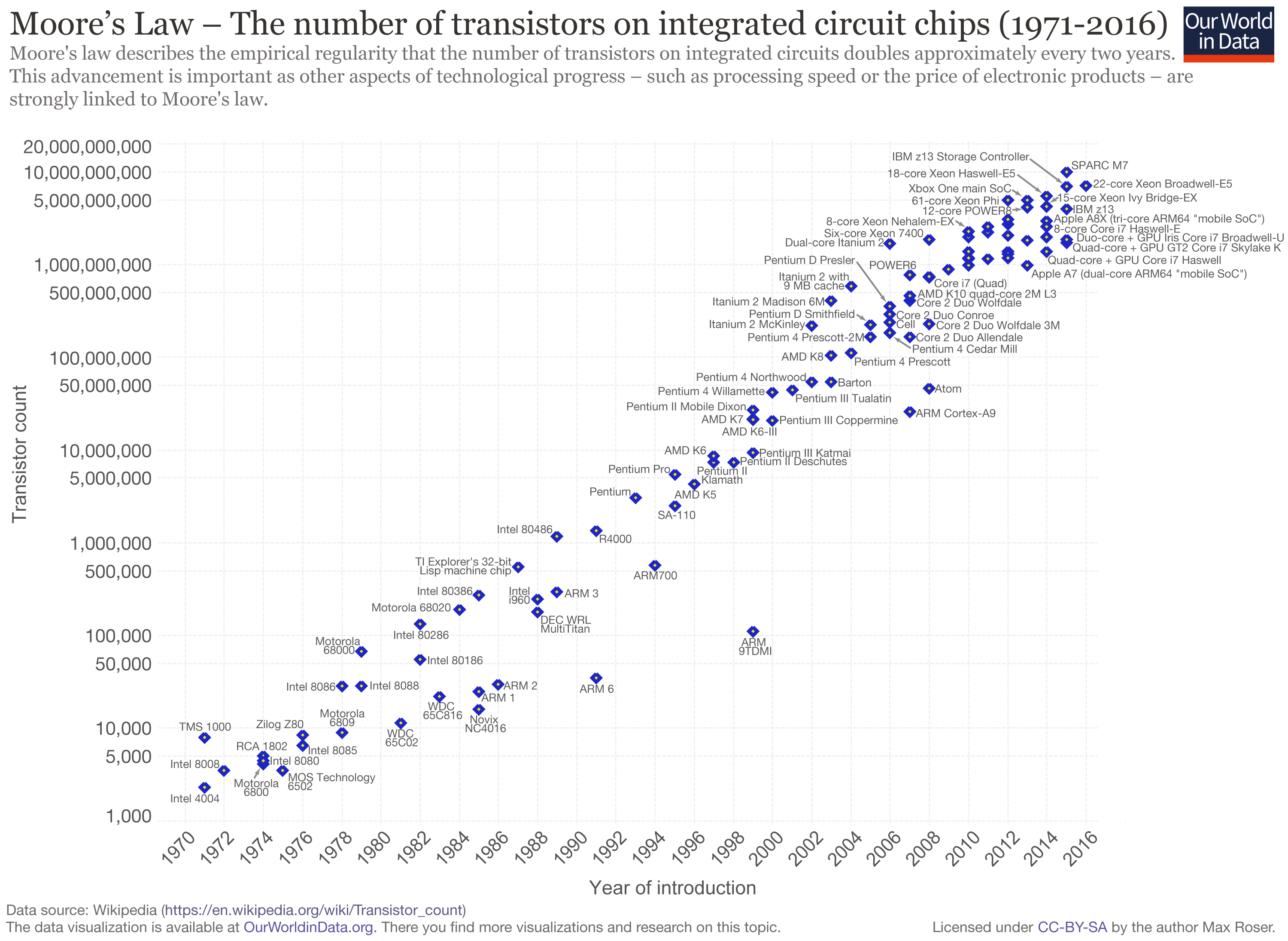As an electrical engineering major, my primary run-in with nanotechnology involves the groundbreaking evolution of the transistor over the last several decades. The transistor is an electrical component that serves as the fundamental building block of digital computers as we know them today. In simple terms, they allow us to use electricity to "control" bits of information ("0"s for low current and "1"s for high current). Huge ensembles of these transistor devices operating together in a single system allow computers to have memory.
 |
| The first transistor, invented at Bell Labs in 1947, could fit in your palm, and was used as an amplifier. |
The first transistor was created at Bell Labs in 1947, and was a relatively large device that could fit in the palm of someone's hand. While this device represented a historical milestone (its creators were awarded the Nobel Prize in Physics), its size made it completely impractical for use in ways that we are familiar with today. Consider modern audio MP3 files, which are typically about 1 megabyte per minute of audio. 1 megabyte is 8 million bits, and if we consider that a single transistor can"hold" 1 bit of information, we quickly realize the impracticality of a palm-sized transistor!
Instead, what we have seen in the following decades is a miraculous burst in the development of technologies to make transistors smaller and smaller. Moore's Law theorized that technology would accelerate at a rate such that the number of transistors that can fit into a given area would double every 18 months. This theory has held remarkably well for the last 50 years.
Instead, what we have seen in the following decades is a miraculous burst in the development of technologies to make transistors smaller and smaller. Moore's Law theorized that technology would accelerate at a rate such that the number of transistors that can fit into a given area would double every 18 months. This theory has held remarkably well for the last 50 years.
 |
| Moore's Law has remained remarkably accurate since the 1970s, illustrating the exponential improvement in integrated circuit fabrication processes |
In 1971, transistors were fabricated using a technology known as a "10 micro-meter process", referring to the size of the smallest feature that can be accurately produced using that process. As of 2017, with Samsung's shipping of the Galaxy S8, the 10 nano-meter process had reached commercial production, a size-wise improvement of 1000 times.
The history of the transistor and its role in the development of computers is one of the classic examples of how nanotechnology has almost incomprehensibly improved a technology. The ubiquity of computers today in every sector of society, from the sciences to the arts, is a testament to its importance in our lives today. However, it's worth mentioning that even nanotechnology itself has its limits. The sizes of modern transistors are comparable with the size of individual atoms, and we are fast approaching a barrier with regards to how small they can be. Quantum technology, which goes beyond the nanotech scale, attempts to explore the feasibility of storing information bits in the quantum state of singular atoms. Only time can tell how this technology may one day rapidly transform our lives.
Sources
An award containing a replica of the first transistor. Digital image. Wikipedia. Wikimedia Foundation, n.d. Web. 28 May 2017.
<https://upload.wikimedia.org/wikipedia/commons/thumb/b/bf/Replica-of-first-transistor.jpg/220px-Replica-of-first-transistor.jpg>.
Courtland, Rachel. "Intel Finds Moore’s Law’s Next Step at 10 Nanometers." IEEE Spectrum: Technology, Engineering, and Science News. IEEE Spectrum, 30 Dec. 2016. Web. 28 May 2017.
<http://spectrum.ieee.org/semiconductors/devices/intel-finds-moores-laws-next-step-at-10-nanometers>.
Innovation Enabled Technology Pipeline. Digital image. Techspot.com. N.p., n.d. Web. 28 May 2017.
<http://www.techspot.com/images2/news/bigimage/2012/2012-09-13-image-12.jpg>.
"Making Stuff: Smaller." NOVA. PBS. Arlington, VA, 26 Jan. 2011. Television.
"Nanotechnology in Electronics: Nanoelectronics." UnderstandingNano.com. Hawk's Perch Technical Writing, LLC, n.d. Web. 28 May 2017.
<http://www.understandingnano.com/nanotechnology-electronics.html>.
Roser, Max. Transistor Count Over Time. Digital image. OurWorldInData.org. N.p., n.d. Web. 28 May 2017.
<https://ourworldindata.org/wp-content/uploads/2013/05/Transistor-Count-over-time.png>.
Wolverton, Troy. "With Moore's Law in doubt, eyes turn to quantum computing." SiliconBeat. SiliconBeat, 04 May 2016. Web. 28 May 2017.
<http://www.siliconbeat.com/2016/05/04/moores-law-doubt-eyes-turn-quantum-computing/?doing_wp_cron=1496015532.8847010135650634765625>.
Its really cool how you work with nanotechnology with your major, and your explanation of the transistor realy helped me understand the concept. I wrote about nanotechnology on the atomic level, so looking at this interesting topic from a different perspective is interesting to look at. It really makes me think about how common nanotechnology realy is, and its only in the rise. Great blog!
ReplyDelete